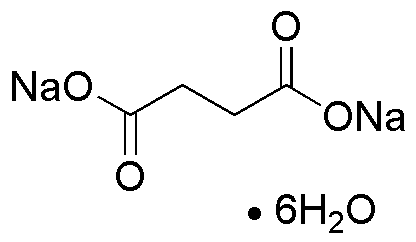Sodium succinate dibasic hexahydrate is widely utilized in research focused on:
- Biochemical Research: It serves as a buffering agent in various biochemical assays, helping to maintain pH stability during experiments, which is crucial for accurate results.
- Pharmaceutical Formulations: This compound is used in the development of drug formulations, enhancing solubility and bioavailability of active pharmaceutical ingredients, making medications more effective.
- Food Industry: It acts as a food additive, improving flavor and stability in processed foods, which is beneficial for manufacturers aiming to enhance product quality.
- Agricultural Applications: Sodium succinate dibasic hexahydrate is employed as a fertilizer additive, promoting plant growth by improving nutrient uptake, which is essential for agricultural productivity.
- Cosmetic Products: It is included in cosmetic formulations for its moisturizing properties, helping to improve skin hydration and texture, appealing to consumers looking for effective skincare solutions.
General Information
Properties
Safety and Regulations
Applications
Sodium succinate dibasic hexahydrate is widely utilized in research focused on:
- Biochemical Research: It serves as a buffering agent in various biochemical assays, helping to maintain pH stability during experiments, which is crucial for accurate results.
- Pharmaceutical Formulations: This compound is used in the development of drug formulations, enhancing solubility and bioavailability of active pharmaceutical ingredients, making medications more effective.
- Food Industry: It acts as a food additive, improving flavor and stability in processed foods, which is beneficial for manufacturers aiming to enhance product quality.
- Agricultural Applications: Sodium succinate dibasic hexahydrate is employed as a fertilizer additive, promoting plant growth by improving nutrient uptake, which is essential for agricultural productivity.
- Cosmetic Products: It is included in cosmetic formulations for its moisturizing properties, helping to improve skin hydration and texture, appealing to consumers looking for effective skincare solutions.
Documents
Safety Data Sheets (SDS)
The SDS provides comprehensive safety information on handling, storage, and disposal of the product.
Product Specification (PS)
The PS provides a comprehensive breakdown of the product’s properties, including chemical composition, physical state, purity, and storage requirements. It also details acceptable quality ranges and the product's intended applications.
Certificates of Analysis (COA)
Search for Certificates of Analysis (COA) by entering the products Lot Number. Lot and Batch Numbers can be found on a product’s label following the words ‘Lot’ or ‘Batch’.
*Catalog Number
*Lot Number
Certificates Of Origin (COO)
This COO confirms the country where the product was manufactured, and also details the materials and components used in it and whether it is derived from natural, synthetic, or other specific sources. This certificate may be required for customs, trade, and regulatory compliance.
*Catalog Number
*Lot Number
Safety Data Sheets (SDS)
The SDS provides comprehensive safety information on handling, storage, and disposal of the product.
DownloadProduct Specification (PS)
The PS provides a comprehensive breakdown of the product’s properties, including chemical composition, physical state, purity, and storage requirements. It also details acceptable quality ranges and the product's intended applications.
DownloadCertificates of Analysis (COA)
Search for Certificates of Analysis (COA) by entering the products Lot Number. Lot and Batch Numbers can be found on a product’s label following the words ‘Lot’ or ‘Batch’.
*Catalog Number
*Lot Number
Certificates Of Origin (COO)
This COO confirms the country where the product was manufactured, and also details the materials and components used in it and whether it is derived from natural, synthetic, or other specific sources. This certificate may be required for customs, trade, and regulatory compliance.


